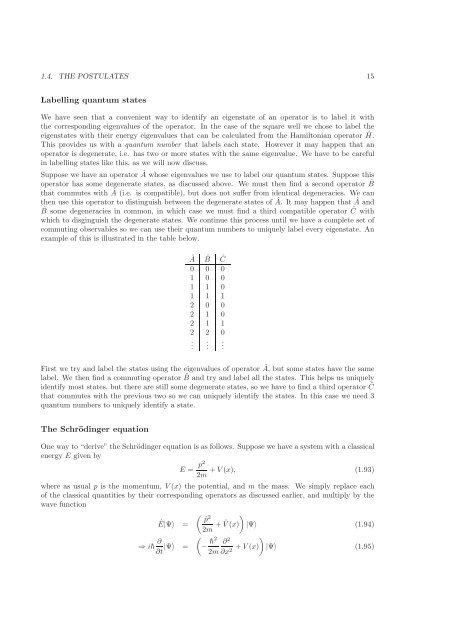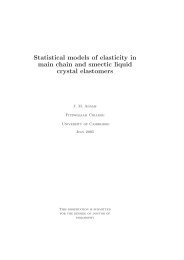Review of Quantum Physics
Review of Quantum Physics
Review of Quantum Physics
You also want an ePaper? Increase the reach of your titles
YUMPU automatically turns print PDFs into web optimized ePapers that Google loves.
1.4. THE POSTULATES 15Labelling quantum statesWe have seen that a convenient way to identify an eigenstate <strong>of</strong> an operator is to label it withthe corresponding eigenvalues <strong>of</strong> the operator. In the case <strong>of</strong> the square well we chose to label theeigenstates with their energy eigenvalues that can be calculated from the Hamiltonian operator Ĥ.This provides us with a quantum number that labels each state. However it may happen that anoperator is degenerate, i.e. has two or more states with the same eigenvalue. We have to be carefulin labelling states like this, as we will now discuss.Suppose we have an operator  whose eigenvalues we use to label our quantum states. Suppose thisoperator has some degenerate states, as discussed above. We must then find a second operator ˆBthat commutes with  (i.e. is compatible), but does not suffer from identical degeneracies. We canthen use this operator to distinguish between the degenerate states <strong>of</strong> Â. It may happen that  andˆB some degeneracies in common, in which case we must find a third compatible operator Ĉ withwhich to disginguish the degenerate states. We continue this process until we have a complete set <strong>of</strong>commuting observables so we can use their quantum numbers to uniquely label every eigenstate. Anexample <strong>of</strong> this is illustrated in the table below. ˆB Ĉ0 0 01 0 01 1 01 1 12 0 02 1 02 1 12 2 0......First we try and label the states using the eigenvalues <strong>of</strong> operator Â, but some states have the samelabel. We then find a commuting operator ˆB and try and label all the states. This helps us uniquelyidentify most states, but there are still some degenerate states, so we have to find a third operator Ĉthat commutes with the previous two so we can uniquely identify the states. In this case we need 3quantum numbers to uniquely identify a state.The Schrödinger equationOne way to “derive” the Schrödinger equation is as follows. Suppose we have a system with a classicalenergy E given byE = p2+V(x), (1.93)2mwhere as usual p is the momentum, V(x) the potential, and m the mass. We simply replace each<strong>of</strong> the classical quantities by their corresponding operators as discussed earlier, and multiply by thewave function( ) ˆp2Ê|Ψ〉 =2m + ˆV(x) |Ψ〉 (1.94)⇒ i¯h ∂ (∂t |Ψ〉 = − ¯h2 ∂ 2 )2m∂x 2 +V(x) |Ψ〉 (1.95)
















